 W
WThis is an incomplete list of works, including nearly all the finished paintings but excluding preparatory black and white sketches, by Claude Monet, who was a founder of French impressionist painting, and the most consistent and prolific practitioner of the movement's philosophy of expressing one's perceptions before nature, especially as applied to plein-air landscape painting. The term Impressionism is derived from the title of his painting Impression, Sunrise.
 W
WAnglers on the Seine at Poissy is an 1882 painting by the French Impressionist Claude Monet. It was acquired in 1942 by the Kunsthistorisches Museum of Vienna but was later, as part of a reoganisation of their artwork, transferred to its current home in the Schloss Belvedere in the same city.
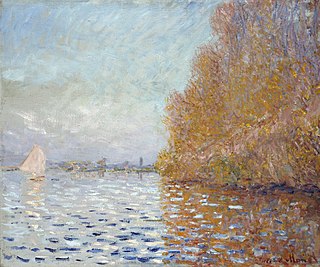 W
WArgenteuil Basin with a Single Sailboat is an oil on canvas autumn scene of the basin at Argenteuil, painted by French Impressionist artist Claude Monet in 1874.
 W
WArrival of the Normandy Train, Gare Saint-Lazare, also known as The Railway Station of Saint Lazare in Paris, is a c. 1877 painting by Claude Monet. It is exhibited at the Art Institute of Chicago.
 W
WThe Artist's Garden at Giverny is an oil on canvas painting by Claude Monet done in 1900 now the Musée d'Orsay, Paris.
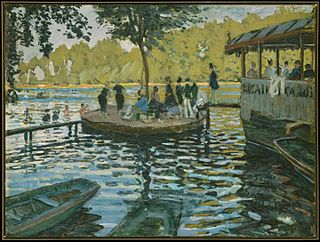 W
WBain à la Grenouillère is an 1869 painting by the French impressionist painter, Claude Monet.. It depicts "Flowerpot Island", also known as the Camembert, and the gangplank to La Grenouillère, a floating restaurant and boat-hire on the Seine at Croissy-sur-Seine. He was accompanied by Pierre-Auguste Renoir, who also painted the scene at the same time.
 W
WLe Bassin Aux Nymphéas is one of the series of Water Lilies paintings by French impressionist artist Claude Monet. It is an oil on canvas painting measuring 100x300 cm.
 W
WBeach in Pourville is a painting by French artist Claude Monet. It is one of an 1882 series of oil-on-canvas works by Monet in the small seaside resort of Pourville-sur-Mer, near Dieppe in northern France. Monet is considered one of the most important members of the group of painters identified as the Impressionists. The painting was bought by the National Museum, Poznań, Poland in 1906 and exhibited in the display of their collection.
 W
WBoating on the River Epte is an 1890 oil painting by French impressionist artist Claude Monet. It is currently housed at the São Paulo Museum of Art.
 W
WBords de la Seine à Argenteuil is an oil painting controversially not accepted by the Wildenstein Institute which publishes the catalogue raisonné of works by Claude Monet. The painting is a landscape depicting the River Seine at Argenteuil in France. It is owned by Englishman David Joel.
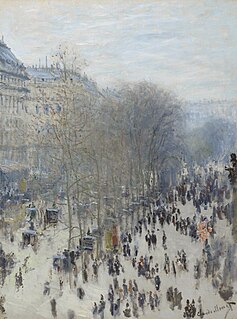 W
WBoulevard des Capucines is an oil on canvas street scene painting of the famous Paris boulevard by French Impressionist artist Claude Monet created in 1873.
 W
WA Cart on the Snowy Road at Honfleur is an oil-on-canvas snowscape painting by French impressionist Claude Monet. The painting depicts a man on a wooden cart travelling along a snow-laden road in Honfleur.
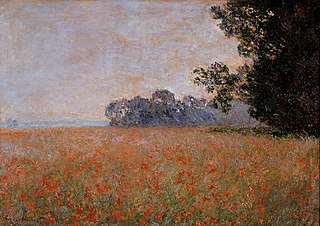 W
WChamp d'avoine aux coquelicots is a 1890 landscape painting by the French Impressionist Claude Monet. It is now on display in the Musée d'Art moderne et contemporain of Strasbourg, France. Its inventory number is 55.974.0.683.
 W
WThe Cliff Walk at Pourville is an 1882 painting by the French Impressionist painter Claude Monet. It currently resides at the Art Institute of Chicago. It is a landscape painting featuring two women atop a cliff above the sea.
 W
WLe Déjeuner sur l'herbe is an 1866–1867 painting by Claude Monet, a smaller version of a slightly earlier work now in the Musée d'Orsay. It is now in the Pushkin Museum in Moscow.
 W
WLe Déjeuner sur l'herbe is an 1865–1866 oil on canvas painting by Claude Monet, produced in response to the 1863 work of the same title by Édouard Manet. It remained unfinished, but two large fragments are now in the Musée d'Orsay in Paris, whilst a smaller 1866–1867 version is now in the Pushkin Museum in Moscow.
 W
WL'Enfant a la tasse or L'Enfant a la tasse, portrait de Jean Monet is an oil painting by Impressionist Claude Monet created in 1868. The painting – which features Monet's son Jean sitting next to a white and blue striped cup – is Monet's third painting to feature his son.
 W
WGarden at Bordighera, Morning is an 1884 oil on canvas painting by Claude Monet, now in the Otto Krebs collection at the Hermitage Museum, first displayed to the public in 1995.
 W
WThe Garden at Sainte-Adresse is a painting by the French impressionist painter Claude Monet.. The painting was acquired by the Metropolitan Museum of Art after an auction sale at Christie's in December 1967, under the French title La terrasse à Sainte-Adresse. The painting was exhibited at the 4th Impressionist exhibition, Paris, April 10–May 11, 1879, as no. 157 under the title Jardin à Sainte-Adresse.
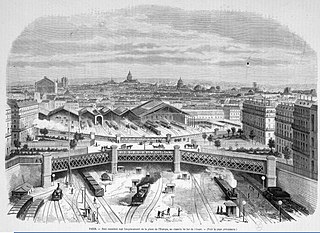 W
WAfter working on rural landscapes, Claude Monet returned to Paris in 1877 and made a dozen oil paintings of the Gare Saint-Lazare railway station in Paris. This was Monet's first series of paintings concentrating on a single theme.
 W
WThe Grand Quai at Le Havre is an incomplete 1874 oil on canvas painting by Claude Monet, now in the Otto Krebs collection at the Hermitage Museum..
 W
WHaystacks is the common English title for a series of impressionist paintings by Claude Monet. The principal subject of each painting in the series is stacks of harvested wheat. The title refers primarily to a twenty-five canvas series which Monet began near the end of the summer of 1890 and continued through the following spring, though Monet also produced five earlier paintings using this same stack subject.
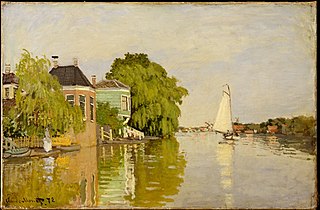 W
WHouses on the Achterzaan is an 1871 painting by French artist Claude Monet. Done in oil on canvas, the work depicts riverside garden houses on the west shore of the Achterzaan river in Zaandam, the Netherlands. He painted it from the dam in the Zaan, facing northwest. The painting is in the collection of the Metropolitan Museum of Art.
 W
WImpression, Sunrise is a painting by Claude Monet first shown at what would become known as the "Exhibition of the Impressionists" in Paris in April, 1874. The painting is credited with inspiring the name of the Impressionist movement.
 W
WLa Japonaise is a 1876 painting by the French impressionist painter, Claude Monet.. The full-length portrait depicts a European woman in a red kimono standing in front of a wall decorated by Japanese fans. Monet's first wife Camille Doncieux modeled for this painting. The painting was first exhibited in the second Impressionism exhibition of 1876.
 W
WThe Magpie is an oil-on-canvas landscape painting by the French Impressionist Claude Monet, created during the winter of 1868–1869 near the commune of Étretat in Normandy. Monet's patron, Louis Joachim Gaudibert, helped arrange a house in Étretat for Monet's girlfriend Camille Doncieux and their newborn son, allowing Monet to paint in relative comfort, surrounded by his family.
 W
WThe Mount Kolsaas series of oil paintings was created by the French Impressionist painter Claude Monet in 1895.
 W
WOn the Bank of the Seine, Bennecourt or River Scene at Bennecourt is an 1868 oil on canvas painting by Claude Monet, now in the collection of the Art Institute of Chicago, to which it was given by the Palmer family in 1922.
 W
WThe Poplars series paintings were made by Claude Monet in the summer and fall of 1891. The trees were in a marsh along the banks of the Epte River a few kilometers upstream from Monet's home and studio. To reach his floating painting studio that was moored in a place he went by small boat up the nearby waterway to where it joined the mainstream. The trees were along the riverside in single file, following along an S-curve. There were three groups of paintings — in one group the paintings have towering Poplars that go off the top edge of the canvas, in another group, there are seven trees and in another group three or four Poplars on the banks of the Epte River near Giverny. The trees, which actually belonged to the commune of Limetz, were put up for auction before Monet had completed all of his paintings. At a certain point, Monet was forced into buying the trees because he still wasn't finished with his paintings. After he finished the series he sold the trees back to the lumber merchant who wanted them.
 W
WPortrait of Père Paul, also known as Monsieur Paul or The Chef, is a painting by Claude Monet.
 W
WThe Pyramides at Port-Coton, Rough Sea is a series of six paintings produced by Claude Monet in 1886. They all show the rocky Atlantic coast of Belle-Île-en-Mer, visited and painted in the plein air by the artist between 12 September and 25 October that year.
 W
WThe Red Cape, also sometimes known as Madame Monet or The Red Kerchief, is an oil-on-canvas snowscape by French impressionist Claude Monet. The painting depicts Claude Monet's wife, Camille, passing outside of a window dressed in a red cape.
 W
WRegatta at Argenteuil is a c. 1872 painting by Claude Monet, now in the Musée d'Orsay. It was left to the French state in 1894 by the painter and collector Gustave Caillebotte.
 W
WThe Regatta at Sainte-Adresse is an oil-on-canvas painting by the impressionist painter Claude Monet. It was painted in 1867 and is owned by the Metropolitan Museum of Art.
 W
WThe Road in Front of Saint-Simeon Farm in Winter is an oil-on-canvas snowscape painted by French impressionist Claude Monet. It depicts a snow-covered road in front of a barn, with tracks of a horse cart and various footsteps in the snow. The painting is one of four related works from the winter of 1867, and represents Monet’s earliest series. They include this work, followed by Road to the Farm, Saint-Siméon, Honfleur, Road in Front of Saint-Siméon Farm in Winter, and Cart on a Snowy Road at Honfleur.
 W
WThe Rouen Cathedral series was painted in the 1890s by French impressionist Claude Monet. The paintings in the series each capture the façade of the Rouen Cathedral at different times of the day and year and reflect changes in its appearance under different lighting conditions.
 W
WThe Seine at Argenteuil is an 1873 oil painting by Claude Monet, one of a series of paintings the artist made of the area.
 W
WThe Seine at Asnières is an 1873 oil on canvas painting by Claude Monet, now in the Hermitage Museum in St Petersburg. It was previously in the collection of Alice Meyer, widow of the extremely rich Hamburg businessman Eduard Lorenz Lorenz-Meyer (1856-1926) before being looted by the USSR after World War Two and retained as war reparations. It has been on public display since an exhibition in 1995.
 W
WThe Seine at Rouen is an 1872 oil on canvas painting by Claude Monet, now part of the Otto Krebs collection at the Hermitage Museum in Saint Petersburg.. It shows a sunny scene of sailing boats moored by the quays on the Seine in Rouen.
 W
WSnow at Argenteuil is an oil-on-canvas landscape painting from the Impressionist artist Claude Monet. It is the largest of no fewer than eighteen works Monet painted of his home commune of Argenteuil while it was under a blanket of snow during the winter of 1874–1875. This painting—number 352 in Wildenstein’s catalogue of the works of Monet—is the largest of the eighteen. The attention to detail evident in the smaller paintings is less evident in this larger picture. Instead, Monet has rendered large areas of the canvas in closely like tones and colours of blue and grey. The application of smaller strokes of greens, yellows, reds and darker blues breaks up these large expanses, and the almost choreographed dispersal of these various colours helps bind the picture together. Paint at the depicted road surface is thicker than elsewhere in the painting, and impasto is suggestive of the feel of disturbed snow.
 W
WSpringtime or The Reader is an 1872 painting by the French Impressionist painter Claude Monet. It depicts his first wife, Camille Doncieux, seated reading beneath a canopy of lilacs. The painting is presently held by the Walters Art Museum.
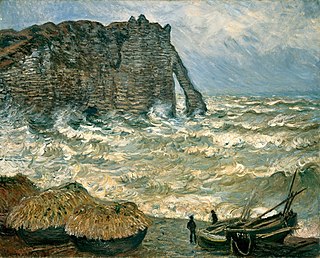 W
WThe Stormy Sea in Étretat is an 1883 painting by one of the founders of French Impressionism, Claude Monet. The painting is now preserved at the Musée des Beaux-Arts de Lyon.
 W
WThe Studio Boat is a painting done in the impressionist style in 1876 by the French artist Claude Monet. The work was executed en plein air in oil on canvas with a size of 72 by 60 cm and currently belongs in the collection of the Barnes Foundation of Philadelphia.
 W
WStudy of Rocks; Creuse: 'Le Bloc' is an 1889 painting by Claude Monet. It is an oil on canvas and measures 72.4 x 91.4 cm.
 W
WThe Valley of the Nervia is a late 19th-century painting by French artist Claude Monet. The work is in the collection of the Metropolitan Museum of Art.
 W
WThe Water Lilies is a 1919 painting by impressionist Claude Monet, one of his Water Lilies series. The painting, the left hand panel of a large pair, depicts a scene in Monet's French pond showing light reflecting off the water with water lilies on the surface. It is on display in New York's Metropolitan Museum of Art.
 W
WWater Lilies is a series of approximately 250 oil paintings by French Impressionist Claude Monet (1840–1926). The paintings depict his flower garden at his home in Giverny, and were the main focus of his artistic production during the last thirty years of his life. Many of the works were painted while Monet suffered from cataracts.
 W
WWeeping Willow is a 1918 oil painting by Claude Monet which depicts a Weeping Willow tree growing at the edge of his water garden pond in Giverny, France. It is exhibited at the Columbus Museum of Art in Columbus, Ohio.
 W
WWindmill at Zaandam or Windmill and Boat at Zaandam is an 1871 oil painting by Claude Monet. Since 1986 it has been in the Ny Carlsberg Glyptotek.
 W
WWoman in the Garden is a painting begun in 1866 by Claude Monet when he was a young man of 26. The work was executed en plein air in oil on canvas with a relatively large size of 82 by 101 cm. and currently belongs in the collection of the Hermitage Museum in St Petersburg, Russia.
 W
WWoman with a Parasol - Madame Monet and Her Son, sometimes known as The Stroll is an oil-on-canvas painting by Claude Monet from 1875. The Impressionist work depicts his wife Camille Monet and their son Jean Monet in the period from 1871 to 1877 while they were living in Argenteuil, capturing a moment on a stroll on a windy summer's day.
 W
WWomen in the Garden is an oil painting begun in 1866 by French artist Claude Monet when he was 26. It is a large work painted en plein air; the size of the canvas necessitated Monet painting its upper half with the canvas lowered into a trench he had dug, so that he could maintain a single point of view for the entire work. The setting is the garden of a property he was renting. His companion and future wife Camille Doncieux posed for the figures. Monet finished the work indoors, and used magazine illustrations to render fashionable clothing.